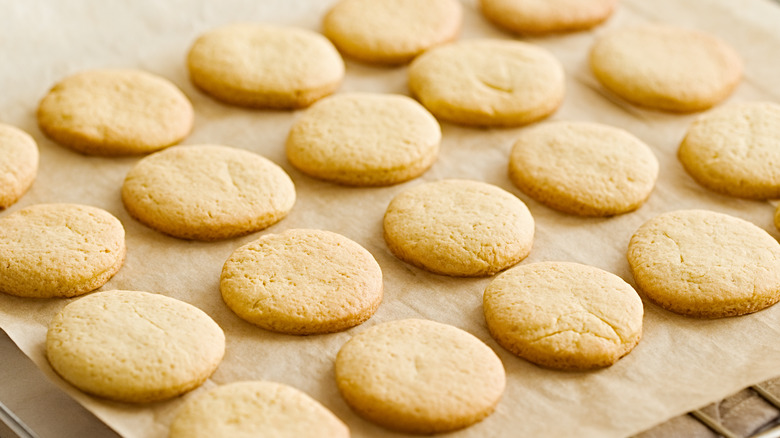Elevate The Crave-Ability Of Shortbread Cookies With Fish Sauce
The perfect shortbread cookie has a delicately flaky texture and buttery, subtly sweet flavor. There's no doubt about the classic cookie's popularity (especially during the holidays and winter months) which comes from its simplicity — it's relatively easy to whip up with just a few staple pantry ingredients on hand.
Some may overlook the Scottish-origin cookie's simple ratio of one part sugar, two parts fat, and three parts flour and write off the shortbread cookie as boring. We beg to differ and see this blank slate cookie for its versatility. It allows the creative freedom of the chef to add a variety of extracts, glazes, or fillings to jazz up this classic.
Even a simple prep tip can elevate these cookies. Taste of Home notes that the secret to the best shortbread cookie is letting the dough sit in the refrigerator for 30 minutes in order to firm up the butter and develop the flavors prior to baking. Indeed, the inherent buttery nature of this cookie is crave-able, but in addition to the preparation method, there's one unexpected ingredient you can add to your shortbread that will make your mouth water and keep you reaching for more.
Fish sauce's savory notes brighten shortbread's buttery flavor
The savory-sweet combo has long gifted us with mouth-watering delights such as salted caramel. So it makes sense that adding fish sauce to caramel or even ice cream can take these classics up a notch. Enter the genius idea to add fish sauce to shortbread.
Filipino-American baker and "Mayumu" cookbook author, Abi Balingit, adds just half a teaspoon of Rufina patis, her favorite fish sauce, to her Stamped Calamansi Fish Sauce Shortbread cookies. She notes in an article on Epicurious that the sweet-savory flavor combination of adding fermented ingredients and sauces to foods has long been in her family's traditional recipes.
Fish sauce is used widely in Southeast Asian cuisine in stews, braised meats, and noodle dishes to brighten the flavor profile. While there are a variety of styles and regional origins to the savory sauce, the basic ingredients, fish (most commonly anchovies) and salt, undergo a fermentation process in barrels. This preserves the fish by drawing out the moisture and helps deepen its flavors. The resulting liquid is then strained and bottled. Bon Appetit notes that while the resulting sauce has a pungent aroma, it's a common misconception that it adds a fishy taste. Instead, fish sauce functions more like salt in a recipe, adding savory, umami depth and complexity.
How to add fish sauce to your cookies
Fish sauce can be added directly into cookie dough like an extract or used as a glaze. In her shortbread recipe, Balingit tops her cookies with a glaze consisting of calamansi citrus juice, lime zest, powdered sugar, and a dash of fish sauce. She then brushes the glaze on top of her adorably fish-shaped shortbread cookies and allows the glaze to harden. She notes in her Epicurious article that the resulting flavor is "sweet, sour, and slightly funky, all at the same time," adding that the sugar and citrus temper the fish sauce, without masking all the savory goodness it has to add.
Balingit recommends using Rufina in your cookies, while chef Alton Brown prefers to cook with Red Boat brand. Whatever brand you go with, be sure to avoid fish sauce with added sugar, as those containing just fish and salt are best. Pick up a bottle at your local Filipino or Asian market and add a dash of fish sauce to your next batch of shortbread cookies. We promise you won't look back.


